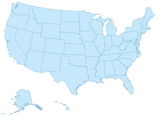- Main article:
Ecology of California
Ecologically, California is one of the richest and most diverse parts of the
world, and includes some of the most endangered ecological communities.
California's diverse geography, geology, soils and climate have generated a
tremendous diversity of plant and animal life. The State of California is part
of the Nearctic
ecozone, and spans a number of
terrestrial ecoregions, and is perhaps the most ecologically diverse state
in the United States.
California has a rather high percentage of
endemic species. California endemics include relict species that have died
out elsewhere, including the redwoods and the Catalina Ironwood (Lyonothamnus
floribundus). Many other endemics originated through differentiation or
adaptive radiation, whereby multiple species develop from a common ancestor
to take advantage of diverse ecological conditions. California's great abundance
of species of California lilac (Ceanothus)
is an example of adaptive radiation. Many California endemics have become
endangered, as urbanization, logging, overgrazing, and the introduction of
exotic species have encroached on their habitat. Furthermore, California is home
to the largest trees in the world, the
Giant Sequoias.
California's native grasses were
perennials, which stayed green year-round in most of the state's subclimates[2].
After European contact, these were generally replaced by
invasive species of European annual grasses; and, in modern times,
California's hills turn a characteristic golden brown in summer and fall.
California's nickname The Golden State is in reference to the
California Gold Rush, and not to the golden brown summer hillsides as is
sometimes stated.[1]


